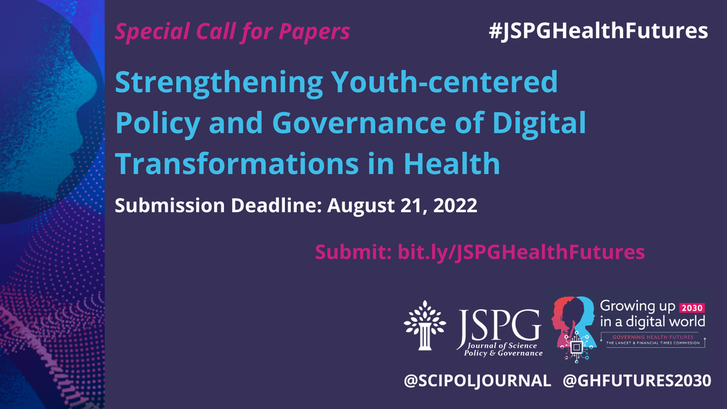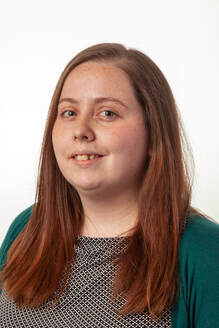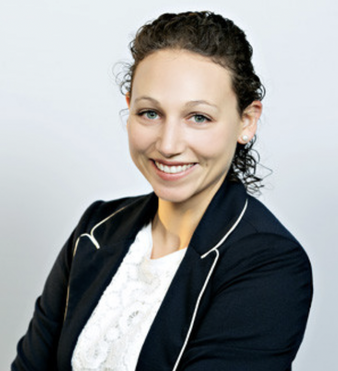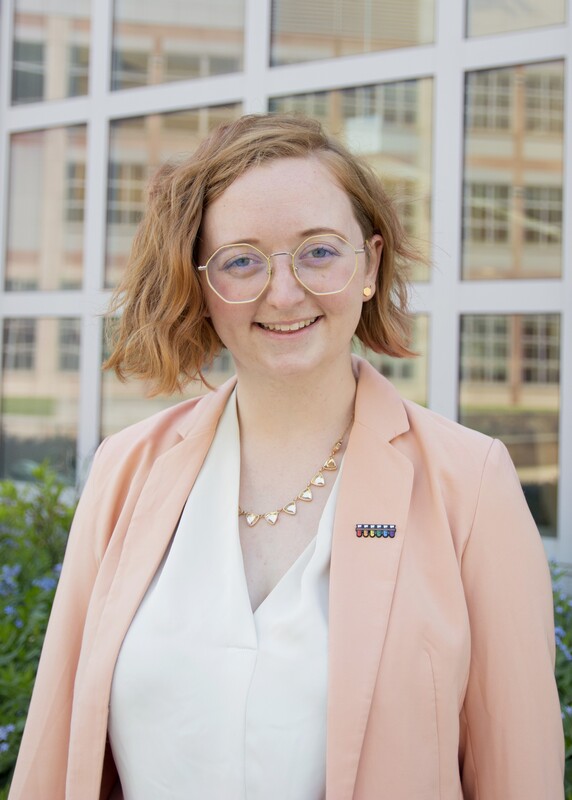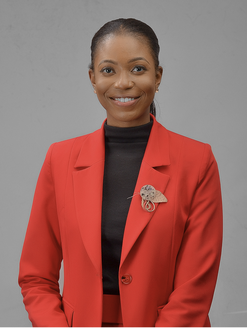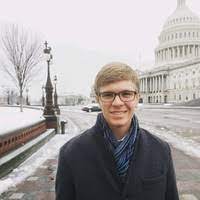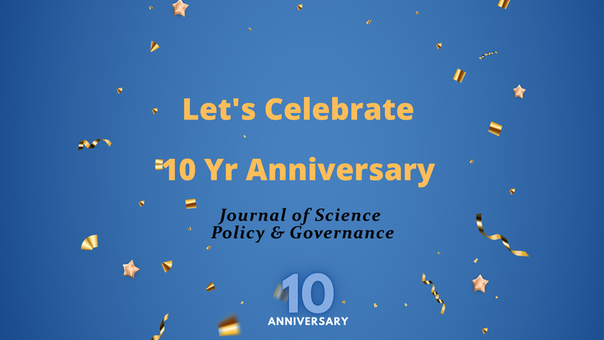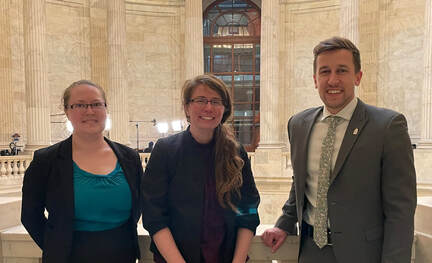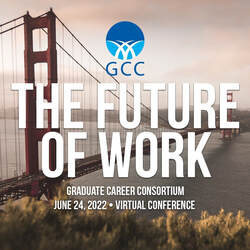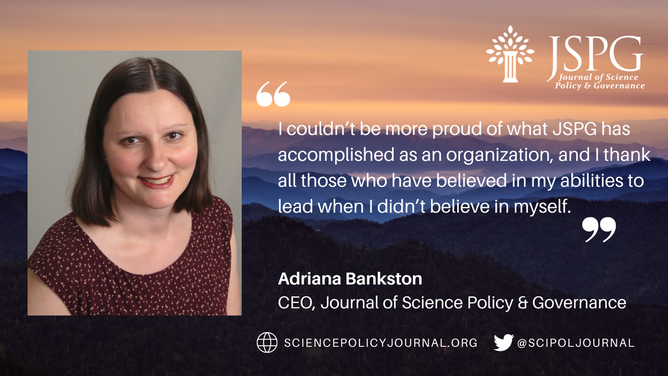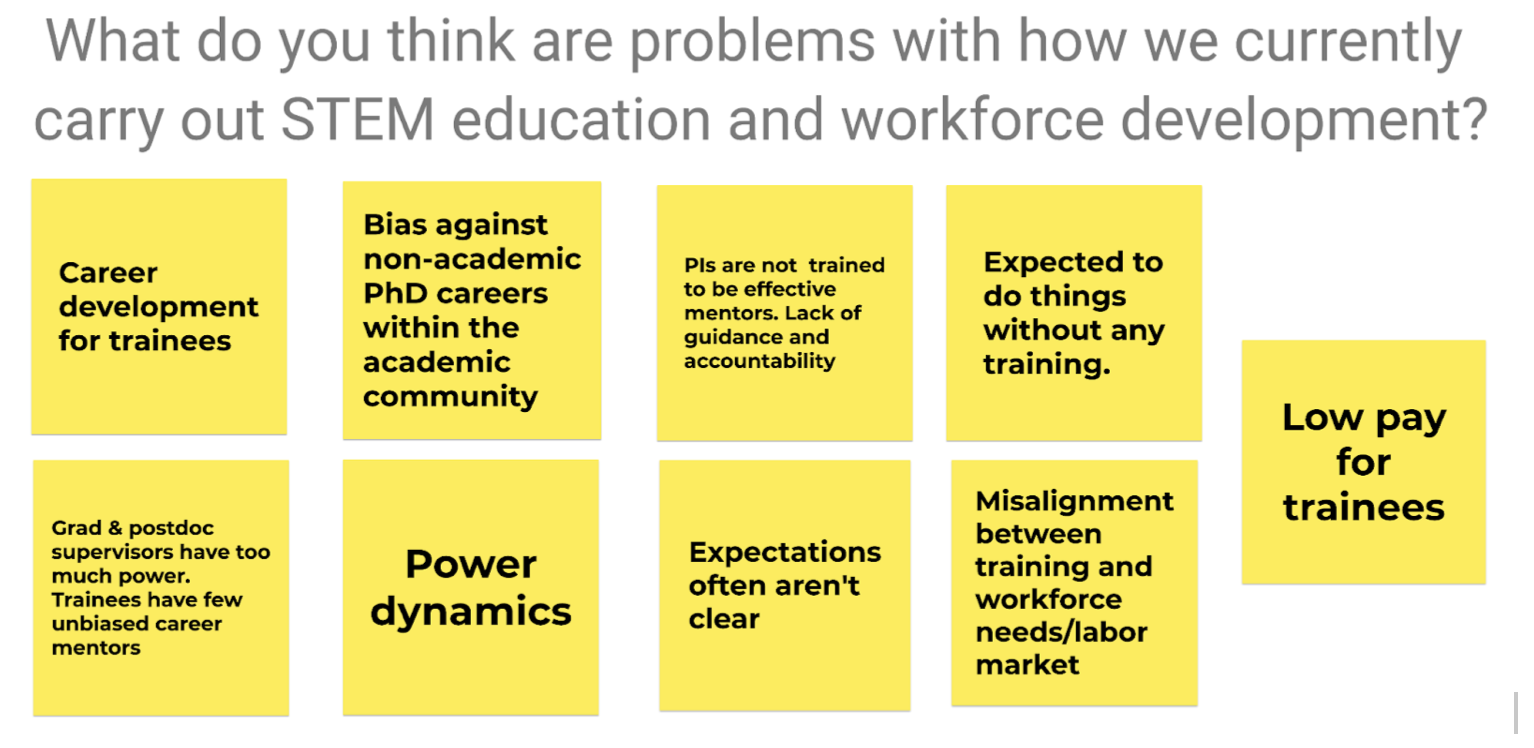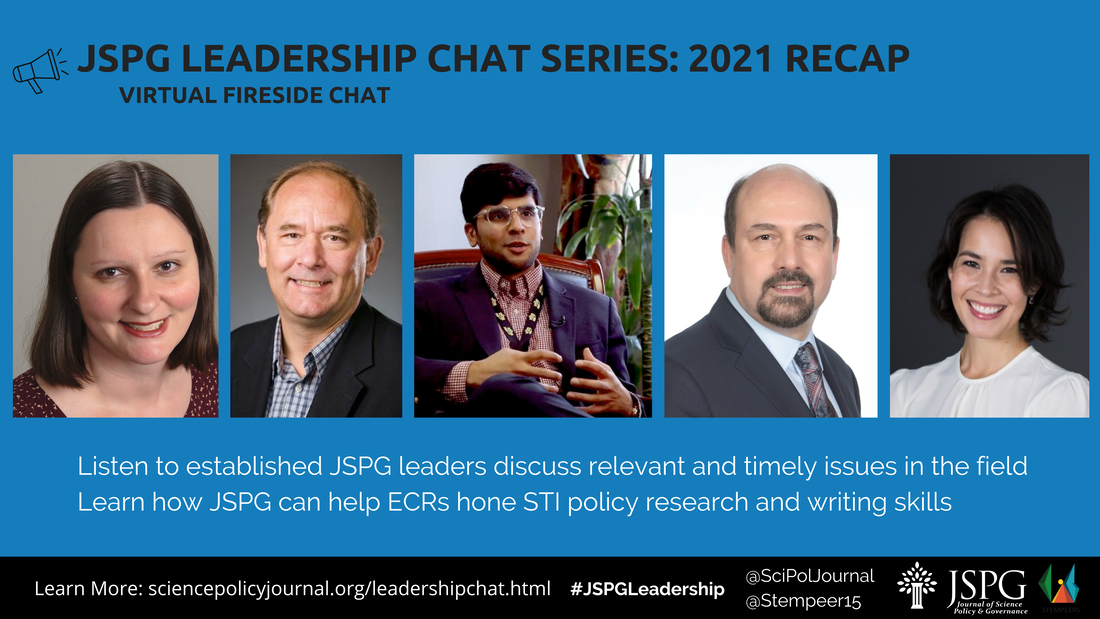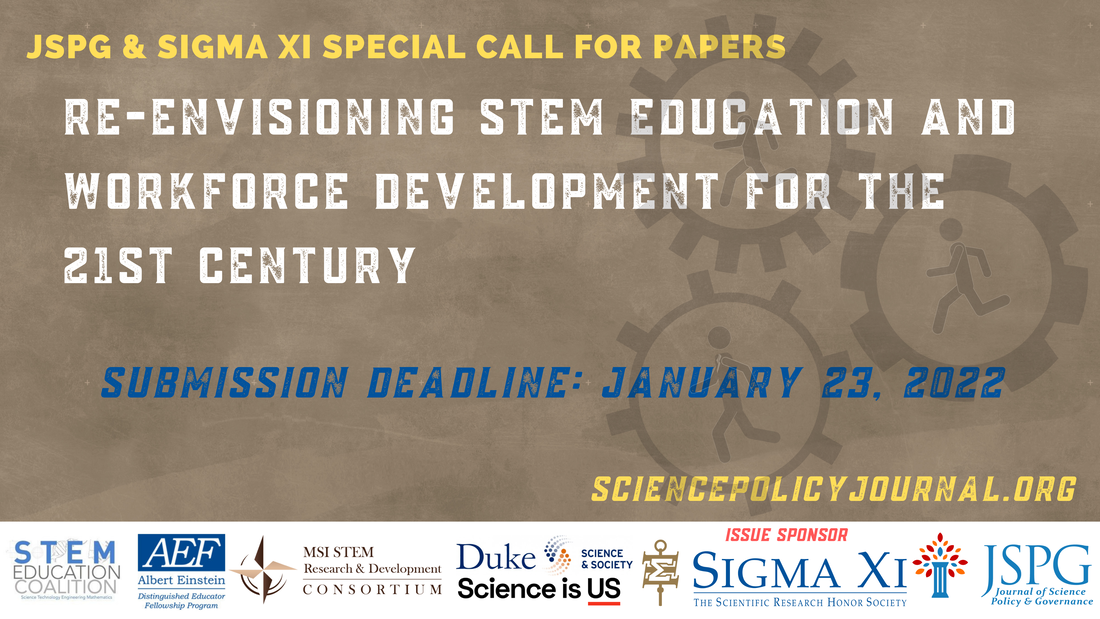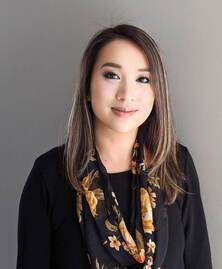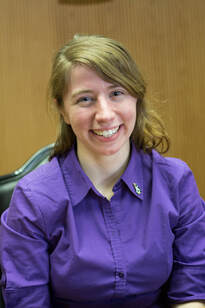|
Introduction
Webinar: Addressing the role of digital technologies as determinants of health Watch the webinar here
Closing
Post compiled and edited by Adriana Bankston.
As an organization focused on early career researchers and their engagement in policymaking, the Journal of Science Policy & Governance (JSPG) celebrates the newly established bipartisan Graduate Research and Development Caucus (GRAD Caucus). The GRAD Caucus is dedicated to the needs of graduate students across the nation, highlighting the “unique and critical role that graduate researchers play in innovation, education, and bolstering our economy.” The launch event took place on Capitol Hill this week. Despite the importance of graduate students in driving innovative research and teaching, little attention has traditionally been paid to the needs of this population at the federal policy level. The GRAD Caucus has the potential to change that narrative. Led by Representatives Mike Doyle (D-PA-18), Gus Bilirakis (R-FL-12), Zoe Lofgren (D-CA-19), and Stephanie Bice (R-OK-5), the GRAD Caucus is the latest development that Washington can use to expand mental health support in academia, improve pay and job quality, and enhance graduate-level training, mentoring, and career preparation for graduate students. JSPG recently published a special issue on STEM education & workforce development, which is in alignment with policy changes highlighted by the GRAD Caucus to support graduate students. The initial one-pager outlined three focus areas for the GRAD Caucus:
Spearheaded by graduate student leaders at Carnegie Mellon University (CMU) and the Massachusetts Institute of Technology (MIT) with efforts starting in 2019, the GRAD Caucus aims to provide legislators with briefings on specific policies and programs, connections to graduate researchers, and a forum to advance policy ideas.
As the GRAD Caucus activities unfold over the coming months, we look forward to engaging with their efforts to support graduate students across the nation in a number of policy areas. Post written by JSPG CEO Adriana Bankston. ### About JSPG
The Journal of Science Policy & Governance (JSPG) is an international, open access peer-reviewed publication managed by and for students, policy fellows, and young scholars in science, technology, and innovation policy. JSPG publishes high-quality articles covering the widest range of topics in formats that are accessible to policymakers. Since 2011, JSPG has served as a vehicle for students and early career researchers to bolster their research and writing credentials in science policy. Visit sciencepolicyjournal.org and follow on Twitter @SciPolJournal to learn more. MEDIA CONTACT
Journal of Science Policy & Governance André Porter communications@sciencepolicyjournal.org (202) 730-9502 Washington, DC (June 25, 2022) – Today, the Journal of Science Policy & Governance (JSPG) celebrates 10 years since its inception as a non-profit organization. Countless individuals have contributed to the success of JSPG, and we thank them for their dedication to our mission of empowering the next generation in science policy. To our authors, thank you for your confidence in the journal and we are excited to be able to offer this platform for you in science policy. To our founder, volunteer staff, editors and editorial leadership, as well as senior advisors, governing and advisory board members, we appreciate all of your help and contributions. We wouldn’t be here without each and every one of you. We would also like to thank our international partners and sponsors who have worked with JSPG over the years and share our mission. It is exciting to look back through our volumes and realize the number of early career authors from several parts of the world who have published in JSPG over these 10 years, on a diversity of timely and relevant topics. While publishing our issues will continue, we are also shifting our focus towards broader international expansion, becoming a more data-driven organization, and driving actionable policy change through published work. At the same time, we will continue to provide professional development opportunities for published authors in science policy. As detailed in a previous post, JSPG has expanded offerings beyond publications into professional development, including workshops and webinars, as well as through the editorial board. We have also engaged in efforts to promote published work through speaking engagements, our new pilot ambassador program and other training initiatives. I’m excited to report that we have been able to make some headway into our goals to expand internationally, as well as to take published ideas into action. But we have more work to do and look forward to future opportunities to partner with established organizations in this space. As we reflect on the past and present, and look to the future, we developed this page to share a few of our successes with the community, as it relates to our data collection efforts and additional highlights. Stay tuned for more to come as we continue to celebrate this anniversary. At the same time, as we are a volunteer organization, we would ask that you continue to stay involved with JSPG to help us achieve our future goals in the next 10 years. We would invite you to donate at this link to help us continue empowering early career authors worldwide and facilitating their engagement in science policy at all levels of government. I am personally very honored to be able to lead JSPG at this critical point in time, and especially on the occasion of our 10 year anniversary. I would like to thank those who have stepped up to help the organization from the beginning, and those who continue to support our mission moving forward as we expand our reach internationally. I am looking forward to our continued collaborations and growth of a joint science policy community that is focused on building the next generation of leaders in this space. Thank you for being part of our celebrations this year! With gratitude, Adriana Bankston JSPG CEO & Managing Publisher ### ABOUT JSPG
The Journal of Science Policy & Governance (JSPG) is an international, open access peer-reviewed publication managed by and for students, policy fellows, and young scholars in science, technology, and innovation policy. JSPG publishes high-quality articles covering the widest range of topics in formats that are accessible to policymakers. Since 2011, JSPG has served as a vehicle for students and early career researchers to bolster their research and writing credentials in science policy. Visit sciencepolicyjournal.org and follow on Twitter @SciPolJournal to learn more. Pictured from left to right is Tamara Savage, Ashley Orr, and Ben Ashman (AAAS Fellow with Sen. Sherrod Brown, OH) at the Hart Senate Office Building. Introduction and framing The Journal of Science Policy & Governance (JSPG) is a 501-c3 non-profit organization based in the United States and an internationally recognized, open-access, peer-reviewed publication dedicated to elevating students, post-docs, policy fellows and young scholars in science, technology and innovation policy and governance debate worldwide. Our mission doesn't begin and end with publication of our volumes. Through national and international partnerships, collaborations, and outreach, JSPG seeks to elevate the visibility and enhance the skills of young scholars in science policy and governance. To this end, we are looking to elevate published work and to showcase ideas published in JSPG in a number of outlets that highlight policy in action. In September 2021, JSPG partnered with the National Science Policy Network (NSPN) to produce a Special Issue on Intersectional Science Policy together with Society for Advancement of Chicanos/Hispanics and Native Americans in Science (SACNAS), 500 Women Scientists and the National Society of Black Engineers (NSBE). The Special Issue focused on a number of aspects related to diversity, equity, inclusion, and justice in science and policy. One of the published memos in the Special Issue, Expanding Access to and Ensuring Equity in the Benefits of Remote Work Following the COVID-19 Pandemic, was co-authored by Ashley E. Orr and Tamara Savage, Ph.D. students at Carnegie Mellon University. The publication calls for Congress to address inequities related to remote work access via expansion of the Telework Enhancement Act. Read the publication here. Taking published work into action The publication ideas were taken into action through funding provided by NSPN to published authors as part of the Special Issue’s contract. To this end, Ashley and Tamara traveled to Washington, D.C. in spring 2022 to discuss their publication with policy makers and local academics, which is a great example of making published ideas relevant to the current policy landscape. Below is their assessment of the trip to DC, in their own words, with a few indicated highlights. In advance of the meetings, we shared the DOI for the memo and indicated we would center our discussion around policies which promote equity in a future of work which leverages remote and hybrid modalities. We were delighted that several of the congressional staffers carefully read the memo in advance of our meetings. They used some of the time in our meetings to ask questions about our research and related policies their Members are advocating for and working on. Our meetings included congressional staffers from Offices of Sen. Sherrod Brown (OH), Sen. Bob Casey (PA), Rep. Mike Doyle (PA), Rep. Mark DeSaulnier (CA), and a White House COVID policy advisor. During these meetings we presented the findings of our research paper with respect to technology enabling remote work's adoption during the pandemic. We discussed the benefits for the workers and firms, while drawing attention to equity considerations in access to remote work. We acknowledged, for instance, how higher educated knowledge workers are more able to work remotely and how remote work requires workers to have reliable high speed internet. Informed in part by what each member of Congress was currently working on, we advocated for expanded high speed internet access, workers’ rights, and workers’ protections. We discussed the Schedules that Work Act, the Part Time Workers Bill of Rights, and expansions of tax incentives for hiring workers with disabilities, among other related policies. We also discussed the Federal Telework Enhancement Act, the key policy prescription from our memo, and how provision of remote work opportunities is important to maintain the competitiveness of federal jobs and even recruit technology workers into new government roles with the US Digital Service, for instance. This trip allowed Tamara and I to practice sharing our research succinctly, an important science policy communication skill. Planning for the meetings allowed us to go beyond our memo’s main policy idea of expanding the Federal Telework Enhancement Act to all firms and to advocate for a menu of policies which collectively seek to address equity in engagement with remote work. We learned more about how policy makers may consider leveraging the tax code to incentivize employers, rather than setting regulations (which may be less politically feasible). We also met with Professor Leah Brooks from George Washington University, who similarly researches remote work, and discussed future research in this area which considers how and to what extent remote work opportunities may address pay gaps and promote labor market inclusion of disadvantaged groups- follow us for more to come on that!
Note: JSPG is a non-partisan organization and the goals of taking published work into action are purely educational and meant to advance the policy ideas of the next generation into action for their own training and professional development.
Blog post written by Ashley Orr and Tamara Savage, with introductions from Adriana Bankston. Connect with Ashley Orr (LinkedIn, Twitter) and Tamara Savage (LinkedIn, Twitter) to talk more about their JSPG published work. Written by Adriana Bankston A Personal Perspective This time last year, I was embarking on what would be my greatest adventure yet as the third CEO of JSPG. This has been a great opportunity to make a difference in something that I’m really passionate about, and I couldn’t ask for anything more than that. On the flip side, being a first time CEO, nothing could have prepared me for all the aspects of this role. In some ways, you have to be doing the job itself in order to understand what it takes to do it, while you are also learning on your feet as a new leader. I have to admit that, a year ago, while I craved the challenge, deep down I was unsure if I could do it well. But I believe that if something is a bit scary but you know it’s good for you, you should say yes and figure out how to do it later. I knew this was a once in a lifetime opportunity. Most immediately after taking on the role, I felt a sense of responsibility to do a good job and continue the path placed before me by those I looked up to. But I realized that this was my opportunity to make a mark, and that I should reflect on what I wanted my legacy to be. Leadership in itself is a privilege, and provides the opportunity to significantly impact the lives of those you work with, mentor, train and interact with. Realizing that everyone looks to you for direction is both incredibly exciting and daunting at the same time. During this time, I reflected on how I could build a positive environment for those in my supervision at the journal. There is a balance of driving towards a common vision, while understanding why others would choose to follow you and their motivations to stay. Looking back, I gained some really valuable insights about myself as a leader through this experience. I still spend a lot of time thinking about what it means to be a good leader and how that aligns with my own values and with those of the organization. By way of wrapping up this introduction, personally I have felt that being a female CEO comes with its own challenges to overcome as women are still underrepresented in leadership roles. I hope to inspire young women who may be thinking about these roles to put their name forward. Lessons Learned This past year in many ways has felt like climbing a mountain, leaving the unknown behind and looking over new horizons for opportunities. But also, this has been very much going between peaks and valleys with ups and downs. I wanted to impart a few lessons learned:
One thing I wish I had done as a leader is to seek out additional mentors early on, or join a leadership peer group to learn more about how to drive change. Overtime, I have sought to educate myself on leadership through articles, books and other programs, while also recognizing that working on your leadership skills is a life-long learning process. Today, I couldn’t be more proud of what JSPG has accomplished as an organization, and I thank all those who have believed in my abilities to lead when I didn’t believe in myself. I’ve certainly gained more confidence in myself through this role and I am a much stronger leader than I was a year ago. I hope that I’ve made our boards and advisors proud this year, and I’m looking forward to the future. Read the second post for more! Written by Adriana Bankston I hope that what we have accomplished this past year as an organization will encourage others to step out of their comfort zone and follow their own path towards something they care about. In the previous post, I focused on my own personal perspectives on leading JSPG, and how I navigated being a first time CEO. I realized that passion is really a driving force for me, and JSPG has provided that opportunity for me to find something that really gets me up in the morning and makes me want to continue going even when things are tough. The idea of driving change itself is important to define for a given organization. What drives you as a leader to make change, and what kind of change do you want to see? Sometimes this means having a very focused direction, and saying no to many other things. In addition to having a limited time within any given leadership role, thinking about what you want your legacy to be is important.
I am privileged to lead the journal at a time when we are approaching JSPG’s 10 year anniversary, which provides opportunities to highlight our accomplishments. In the past couple of years, we have grown considerably in terms of the number of volumes published, ways to showcase published authors at events and in the media, spoken about JSPG in various avenues, and expanded internationally in many aspects. A few things I’m proud of as an organization include:
Finally, I’m also personally proud to have spoken at meaningful forums about policies to support early career researchers, and for the opportunity to delve more deeply into developing the future science policy workforce through a fellowship awarded this year. I’ve felt deeply honored for the opportunity to serve as JSPG CEO over this past year and look forward to the future. I also hope that what we have accomplished this past year as an organization will encourage others to step out of their comfort zone and follow their own path towards something they care about. Stay tuned for more to come with and around our anniversary celebrations this year! Stay in touch with us on Twitter, Facebook, LinkedIn, Instagram, and YouTube, and subscribe to our newsletter for the latest news and opportunities. WORKSHOP RECAP: JSPG, ASU CSI and UK SIN Collaborative Workshop on Re-imagining Climate Futures2/28/2022 Introduction and context On September 7, 2021, the Journal of Science Policy and Governance (JSPG), in partnership with UK Science and Innovation Network and the Center for Science and the Imagination at Arizona State University (CSI) organized a workshop on re-imagining positive climate futures, geared towards early career researchers interested in writing about climate change solutions. The event featured authors who had previously published in JSPG’s climate special issue on climate change solutions sponsored by UK SIN. Authors discussed these topics with ASU CSI's Climate Imagination Fellows, who are talented authors from around the world working on creating stories that envision positive, and scientifically grounded climate futures designed to inspire climate action and efforts for greater resilience by policymakers and other governing bodies. While this event was leading up to the COP26 conference, the topic of climate resilience is an evergreen topic to discuss and highlight ways to create better futures, in particular with the release of the recent IPCC climate report and the COP27 conference coming up later this year. Event recap For this event, Emily Cloke, British Consul General in Los Angeles, covered the UK’s key goals for COP26 and actions taken by the UK towards net zero, as well as plans by the British Consulate in Los Angeles ahead of last year’s conference. Joey Eschrich, editor and program manager at CSI, moderated a panel discussion with CSI Fellows Libia Brenda, Hannah Onoguwe and Vandana Singh (read more about their work). Panelists discussed how to tell a story that responds to local challenges and climate issues, but also speaks to people around the world, and how to get inspired to write fiction about the climate crisis. Published authors from the JSPG/UK-SIN climate special issue participated in subsequent discussions related to the workshop theme, including:
In breakout rooms, workshop participants created their own narratives on climate change policy solutions focused on: climate migration and displacement; advocacy and coalition building; and transforming institutions and industries. CSI fellows, along with published authors from the special issue and other participants, worked on a quick story generation process that involved imagining a realistic real-world setting for climate action, a focal character who represents a community or group of stakeholders, and a conflict animated by divergent visions for the climate future of that setting. Based on the foundation of articles from the special issue, groups explored themes and points of conflict about science, technology, policy, and values that are global in scope, but also play out in complex and diverse ways in different physical and human geographies. In the end, published authors and other early career participants learned about process and improvisation and modeling a way of thinking about imagining positive climate futures.
Interested in partnering on future events with JSPG? Contact CEO Adriana Bankston at CEO@sciencepolicyjournal.org. Post written by Adriana Bankston & Joey Eschrich. Introduction On November 12, 2021, the Journal of Science Policy & Governance (JSPG) in collaboration with Graduate Professional Success in STEM program (GPS-STEM) at UC Irvine and the STEM Advocacy Institute (SAi) organized a workshop on Creating actionable change for STEM education and workforce development. The workshop was focused on discussing ways to support the next generation of scientists who encounter STEM education and training, help them achieve their potential in science and utilize their talents in society. The event featured Dr. Gary McDowell, CEO of Lightoller, LLC and Co-Founder of Future of Research. Watch the event recording here. This workshop is leading up to the JSPG-Sigma Xi call for papers for a Special Issue on Re-envisioning STEM Education and Workforce Development for the 21st Century with a deadline of January 23, 2022, which is a great opportunity for the next generation to shape policy change on this topic. Context setting The U.S. prides itself on the quality of STEM education and training that it provides. But is STEM education and workforce development in the U.S. meeting society’s needs? In particular, are we focusing enough on the people in the system, as well as the outputs they produce? In this session, we wanted to reframe how we envision the future of the research enterprise, and to think more about the individuals who pass through the system who make up the STEM workforce. A NASEM committee produced the most recent report on graduate STEM education, noting that while graduate education works well for funding agencies, institutions, and professors, but that it benefits graduate students least. And while the system may to an extent benefit a proportion of graduate students who are staying in academia, it is debatable whether the system works even for those who stay. This is because the system does not train the next generation on skills they will need to run their own laboratories in the future. And while graduate and postdoctoral training is focused on getting the practical work done from trainees on grants, studies of what happens to those in training roles during and after these positions is poorly studied and unintentional (or at best passive). We need to think more deeply about how we can use the wealth of talent passing through our universities to maximize solving society’s problems while advocating for necessary systemic change. Background During the registration process, we asked early career researchers (ECRs) to describe one aspect of the current STEM educational system that bothers them, and to propose some changes they would like to see as context setting for the discussion. The results are shown below in Table 1, and focus on a number of areas including the lack of career and training opportunities, lack of breadth in training for ways to address societal impact, and other issues inherent to the system itself including low salaries and issues with lack of diversity in STEM. Within the event itself, attendees expressed concern with the current state of affairs of STEM education and workforce development by pointing out the areas where early career researchers face challenges. These include lack of mentoring from faculty, as well as power dynamics, in addition to low salaries and lack of avenues for career and professional development (Figure 1). Breakout summaries Following a presentation by Dr. Gary McDowell, in the breakout rooms, participants dissected some of these topics and discussed more in-depth the problems and solutions to the system in four different areas. The sections below summarize discussions that took place in the breakout rooms. 1. Value of STEM pipeline and potential Background:
2. Scientific literacy and how the scientific process works Background:
3. Value of peer review and relationship to identity as a scientist Background:
4. Exposure of trainees to STEM for addressing societal issues Background:
Overall conclusions Many common problems and solutions have emerged from these discussions, which point to valuable changes that need to be made in the system to support the next generation. These revolve around a number of areas that point to issues related a system that does not train the next generation on ways to manage a laboratory or team of people, or budgets, or multi-personnel projects: we teach people how to do benchwork to a high degree of skill, and then expect them to just pivot to a completely different role as a faculty member. Because the unstated, but clear, goal of graduate and postdoctoral training is to get the practical work done that people have written into their grants, what happens to those in training roles during and after these positions is poorly studied and unintentional (or at best passive), meaning that we are not thinking about how we can use the wealth of talent passing through our institutions to maximize solving society’s problems. Ultimately, these discussions concluded that we need workforce development focused on the trainees as people, not just vessels for research output. The call to action includes more funding and pathways for trainees and faculty wishing to develop and pursue non academic track ventures towards social impact, such as science engagement and informal STEM initiatives that can help. But there is also a broader call to action warranted here whereas several stakeholders, including universities, need to act in ensuring that our next generation workforce is successful in society. Resources For further reading or information, we have compiled a list of resources for ECRs to utilize, and for others who wish to think more about actions to take in improving the research enterprise. You can download the document below. ### About JSPG
The Journal of Science Policy & Governance is a nonprofit organization and open-access peer-reviewed publication managed by and for students, policy fellows and young scholars in science, technology and innovation policy. JSPG publishes high-quality articles covering the widest range of topics in formats that are accessible to policymakers. Since 2011, JSPG has served as a vehicle for students and early career researchers to bolster their research and writing credentials in science policy. Visit sciencepolicyjournal.org and follow on Twitter @SciPolJournal to learn more. About GPS-STEM The Graduate Professional Success in STEM program (GPS-STEM) at University of California Irvine aims to better prepare graduate students and postdoctoral scholars for a variety of careers within the STEM research workforce, and empower trainees to become not only skilled scientists, but also polished professionals. The program was funded from 2014 – 2019 by the NIH-BEST (Broadening Experiences in Scientific Training) grant for providing career & professional development avenues for STEM trainees. Visit https://gps-stem.grad.uci.edu and follow on Twitter @BiomedGps to learn more. About SAi The mission of the Science, Technology, Engineering & Mathematics (STEM) Advocacy Institute (also known as the Science Advocacy Institute or SAi) is to provide access to research, infrastructure, mentorship, community, training, and funding to, put simply, make it easier for diverse founders and leaders to experiment, explore and ultimately build impactful and sustainable informal STEM learning (ISL) programs that strengthen the connections between people and science. Visit https://stemadvocacy.org and follow on Twitter @STEMadvocacy to learn more. About Lightoller LLC Lightoller LLC is a consultancy providing research expertise on the early career researcher population. Visit https://lightoller.org and follow on Twitter @Lightoller_llc to learn more. This post was co-authored by Adriana Bankston (JSPG); Harinder Singh (GPS-STEM); Fanuel Muindi, Erin Saybolt, Moraima Castro-Faix, Nicole Catanzarite, Gwendolyn Bogard (SAi); and Gary McDowell (Lightoller LLC). Since its establishment 10 years ago, the Journal of Science Policy & Governance (JSPG) has been instrumental in elevating the voices of early career researchers in science, technology and innovation policy. The leadership within this organization have been key to pushing forward the goals and the mission of the journal.
In 2021, JSPG launched the Leadership Chat Series to speak directly with those leaders who helped and continue to support the success of the journal, to hear about their experiences with the journal and ways in which JSPG can help early career scholars hone their research and writing skills and progress in their career advancement by publishing in the journal. The series is supported by STEMPeers. The JSPG leadership chat series so far has featured leadership staff, including the journal’s CEO and managing publisher Adriana Bankston and distinguished members of the JSPG Governing Board who support the journal in outreach, development, partnerships, and strategic planning. This series provided a platform for our leaders to expand on their knowledge and help elevate JSPG’s mission internationally, and was one of the initial projects spearheaded by JSPG’s current CEO. In August of this year we first heard from Adriana Bankston, 100 days into her new role as JSPG CEO and Managing Publisher. Adriana Bankston shared her vision for the journal under her tenure and as we move into the new decade. The journal has experienced so much growth over the past several years and what’s unique about the journal, as well as key to its continued success, is being a vehicle to publishing policy work from early career researchers. JSPG has been publishing for an entire decade and our most recent issue highlighted that milestone. Adriana hopes that over the next decade JSPG will continue to reach broader audiences including expanding internationally and elevate our authors' published works to higher platforms. Our second discussion featured JSPG Governing Board Member Toby Smith, and centered around how early career researchers can help shape the future of science policy. This chat highlighted our recently published Special Issue: Shaping the Future of Science Policy in partnership with AAAS and sponsored by the Kavli Foundation. Throughout Toby’s career he has been in position to witness the impact of early career researchers on science policy, and he shared many of those experiences in depth during our very insightful chat. Following our chat with Toby, we next talked with JSPG Governing Board Member, Merhdad Hariri. This conversation was focused around our published Special Issue: Intersectional Science Policy sponsored by the National Science Policy Network, covering the intersection between diversity, equity, inclusion and science policy. There is still so much work to do in this area, but diversity must remain a top priority for our work in science policy. The next two chats featuring JSPG Senior Advisor Shalin Jyotishi and Governing Board Member Lida Beninson were very focused on policy making around STEM education and workforce development. In conjunction with the journal’s call for papers for our Special Issue: Re-envisioning STEM Education and Workforce Development for the 21st Century (submit to the issue by January 23, 2022!), we highlighted during each chat ways that STEM education and workforce policies can be reformed to support a more robust workforce, and expanded upon pathways into the workforce from the expertise of the speakers. In addition, we discussed how STEM education can better align with the labor market for K-12, community college, and higher education sectors to support the current and future workforce. To learn more about this topic, read the blog post written by early career researchers who attended events leading up to the special issue submission deadline. So far in this series, all the Leadership Chats have had one thing in common, and that is to emphasize the impact that early career researchers can have on science, technology and innovation policy no matter where they are in their careers. Whether someone is an undergraduate, graduate student, postdoctoral researcher, policy fellow or early career professional they can have a voice and contribute to the changes they would like to see in policy. JSPG continues to be an innovative, relevant and timely vehicle to elevate the voices of early career researchers in policy making through substantial engagement in policy research, writing and editing. Over the next decade, JSPG will continue to serve in this role and with the support of our distinguished leaders, we hope to impact future generations around the world and contribute to building the next generation of science policy leaders. Learn more about the Leadership Fireside Chat Series here and watch all the chats here. Stay tuned for future chats in 2022! Post written and compiled by Nicole Parker, JSPG’s Director of U.S. Outreach, who led the planning, organizing and execution of the chat series this year. Edited by JSPG CEO, Adriana Bankston. [Events recap] Re-envisioning STEM Education and Workforce Development for the 21st Century12/11/2021
Introduction The Journal of Science Policy & Governance (JSPG) and Sigma Xi, The Scientific Research Honor Society launched a call for papers and competition focused on Re-envisioning STEM Education and Workforce Development for the 21st Century. The call for papers and competition for op-eds and policy position papers will result in a Special Topics Issue of JSPG to be released in 2022 that will comprise the most compelling papers. Read the call for submissions. As part of this partnership, JSPG and Sigma Xi hosted a series of educational webinars led by experts from Advancing Research Impact in Society (ARIS), New America, and the Association of American Universities (AAU) to examine policy changes in STEM education and workforce development, and a policy writing workshop for op-eds and policy position papers to help prospective authors improve their submissions to the special issue. View the event recordings. In addition, as part of the JSPG Leadership Chat Series, our staff interviewed a number of established leaders in science policy at multiple career stages within JSPG, who discussed relevant and timely issues in the field as related to topics published in the journal. This includes JSPG governing board members and JSPG advisors. Many of these speakers have deep knowledge on the topics included in this call for papers, including DEI in Science Policy (Mehrdad Hariri); Shaping the Future of Science Policy (Tobin Smith) and Shaping the Future of Education and Workforce Development (Shalin Jyotishi). The writing workshop provided writing instruction (Deborah Stine) emphasized the importance of science policy training for the next generation of leaders in science policy, which was emphasized in the chat on the topic of Professional Development for Graduate Students and Postdocs (Lida Beninson). Below are summaries of the webinar series, written from the perspective of an early career participant (graduate student, postdoc levels), and a brief summary of the writing workshop. We integrated these chats into the respective summary, as relevant for that particular event leading up to the call for papers.
What drew you to attend? During the COVID-19 pandemic, the world witnessed the scientific process unfold in real time and broadcast through mainstream media. The demand for immediate results did not allow adequate time for scientific replication and further casted doubts about promising findings of new studies. For the general population, it is difficult to sift through numerous new information, and it can also be particularly challenging when knowledge about the scientific process is limited. I was inspired to promote K-12 STEM education so that young people adopt knowledge about the scientific process early on, enabling them to discern quality science upon reading new information. This important skill can be applied in the STEM workforce, through mentorship, and for developing good policies. Upon hearing about the expert panelists speaking on strategies for delivering quality STEM education to K-12 students, I was excited to learn what is currently being done by STEM professionals. The panel was moderated by Thomas Tubon and highlighted three experts in bridging the pathway from K-12 to the STEM workforce. Takeaways from speakers Natalie Kuldell developed a STEM educational program, originally supported by the National Science Foundation (NSF), and sustained the program by starting a non-profit organization that creates teaching labs for educators and students. Natalie noted that the COVID-19 pandemic has unveiled gaps and pitfalls of social systems, resulting in teachers and schools stepping in to fulfill the needs of students, especially for K-12 students from marginalized and underrepresented backgrounds. It is difficult to ask schools to have patience and to invest time with students until they have mastery in skill sets given how many responsibilities have fallen on K-12 schools. There cannot be a one size fits all solution to K-12 education due to a variety of needs across many different communities. There needs to be a connection between the quality of educational resources and empowerment of teachers. With extensive expertise in STEM curriculum design and program evaluation, Teshell Ponteen Greene brings national attention to outreach and access to innovative and advanced STEM education for racially and ethnically diverse K-12 students. Teshell suggested partnering with large organizations and companies, which have already established outreach programs, in order to tap into a talent pool of young underrepresented learners. This will connect K-12 students with local industry employers and organizations. To diversify STEM talent in K-12 education, colleges must provide pathways for teachers earning education degrees with internship opportunities to work in multiple STEM labs. Lastly, educators can build and strengthen alliances by creating opportunities for students from various backgrounds to work together, even internationally, diversifying teamwork in STEM fields. Linnea Fletcher spearheads initiatives to bring industrial biotechnology and cell therapy lessons into classrooms by assisting teachers in adapting to virtual teaching during the COVID-19 pandemic. With support from the National Science Foundation (NSF), Linnea developed a strategy to increase access to biotechnology in K-12 STEM education. Linnea believes that all education should be authentic by having students use applied science, technology, engineering, and math. An example of effective education is having middle school students create products that elementary school students can use. Another point Linnea added was that students working in the industry should get credit for learning new skill sets and translate this knowledge into credits towards their college degree. Industry partnerships are also necessary to deliver applied STEM in schools, and this creates a stream of skills building and opportunities to enter into the STEM workforce after graduation. Overall takeaways To solve a complex problem in STEM education, it requires creative solutions with a robust team of STEM professionals partnering with educators and industry partners. Diversifying science teamwork in education and expanding collaborations locally, nationally, and internationally would strategically create pathways from K-12 to the STEM workforce. Access to quality STEM education for students of all backgrounds benefits society as a whole and can lead to its betterment. Policymakers can re-evaluate lessons learned from the COVID-19 pandemic in regards to maximizing virtual education, expanding quality Internet access to rural communities, and providing equitable resources to low income communities. The goal is to relieve the added strain placed on teachers and schools so that they can fulfill their mastery of educating and mentoring students to be future STEM leaders and professionals. The webinar pairs nicely with Mehrdad Hariri’s JSPG leadership fireside chat focused on DEI in science policy. Mehrdad discussed when he first entered into policy work at the turn of the new millenia, science and policy were separate. Therefore, he took on leadership roles bridging science and policy and paving the way for emerging scientists. Through regular attendance at the AAAS annual meeting and inspired by what he learned, Mehrdad encouraged early career scientists to connect with other science policy experts by attending AAAS events and to engage with them in learning how to be a changemaker, which also applies to students and young people from all backgrounds.
What drew you to attend? As the COVID-19 pandemic impacted the transition of students into 4-year colleges and graduate programs, calls were made to bring classes online, shift to pass/no pass grading, and waive admissions tests as application requirements. Nearly two years later, postsecondary institutions are deciding which education policies to phase out or continue. When I learned about this webinar, I was curious to learn how 3 different institutions were ensuring a successful STEM experience for students and equipping graduates for the careers they would enter into. Toby Smith moderated this conversation, featuring leaders from a liberal arts college, a technical public college, and a private school focused on biomedical graduate programs. Takeaways from speakers Susan Singer shared that the pandemic highlighted the importance of the residential college community as an equalizer, providing all students with access to broadband and communication software. Susan also mentioned SAT/ACT test waivers as a way to increase access to education for undergraduate students, and noted that liberal arts institutions who engage in holistic admissions successfully incorporate multiple factors into admission decisions. Noting that STEM skills can offer benefits even for non-STEM majors, Susan mentioned that incorporating research into general education requirements could be a way to increase access to these skills. This pathway enables all students to develop critical thinking, written communication, and research presentation skills, resulting in postsecondary graduates who are well-prepared for the careers of their choice. Alongside coursework, mentorship was highlighted as a key force in guiding students to “go to college on purpose” so that they may relate their coursework and extracurricular activities to employers as part of their career story about the grand societal challenge they see themselves contributing to. For example, a history major might complete a data science minor in order to enhance their work in an art gallery. Institutions can curate the optimal portfolio of courses through quarterly conversations with industry, a strategy Susan mentioned that 2-year colleges use to build what is needed to ensure well-equipped graduates. With a focus on retention, Kaye Husbands Fealing illuminated options to resolve the “last mile” problem of college completion for enrolled students by reinforcing their sense of belonging and ensuring secured funding for tuition. With these measures in place, students can experience a greater sense of well-being, resulting in the ability to focus on their schoolwork. This work includes the sophisticated technical content that STEM is known for. One challenge in completing this work is accessing support. Kaye underscored the importance of creating culture shifts that facilitate advancement, retention, and graduation by removing this barrier. A key driver of this culture shift is reducing the stigma associated with asking for help, so that the high expectations and rigor are met with a welcoming environment to access support. With this support, students will be set up for success in the gatekeeper courses and beyond. And as students become alumni and engage in the future of work, they may expect to encounter careers where they spend 10 years in one area, then switch to another area of science or even a new industry. In conversations with alumni from Georgia Tech, Kaye heard positive feedback on developing flexible skill sets including non-technical skills like writing, leadership, communication, and history. With an eye toward a robust lifelong learning process, where new skills could be added 20+ years post-graduation, colleges can look over the horizon and anticipate the professional education they might offer for those looking to refresh skills in their current area or train in preparation for a career pivot. Cynthia Fuhrmann suggested that moving to online platforms has enhanced opportunities for students to complete graduate school milestones and diversify their career development options. Virtual qualifying exams, dissertation defenses, and committee meetings have been easier to schedule and are now recognized for being as viable as in-person sessions for these activities. Due to reduced registration costs and elimination of travel fees, graduate students and postdocs can explore more career options. While in the past it may have only been possible to attend conferences where they were presenting scientific work, they are now able to get more out of their conference budgets and attend virtual professional society conferences to learn more about industries they may choose to join. With the apprenticeship model of the PhD strongly focused on being an academic scientist at a time where more PhD graduates are finding roles outside of the academy, Cynthia shared that being more deliberate in how students gain transferable skills like communication and team-oriented work is vital to the future of graduate STEM education. She referred to an NSF report that emphasized the importance of a student-centered pedagogy, where the needs of students inform the design of the program. Programs aligned with the needs of students entering careers outside of the academy produce scientists who communicate with empathy and are able to work interculturally, demonstrating leadership skills in any industry they enter. Overall takeaways The pandemic has heightened awareness of how access to post secondary STEM training can be broadened. From holistic admissions and inclusive retention strategies that promote well-being, through career exploration, launch, and reskilling, institutions offering 4-year colleges and graduate degrees can improve access for students from all backgrounds along the continuum by focusing on the needs of the students they serve. Undergraduate programs can ensure that STEM and non-STEM students receive a balanced education with complementary skills outside their areas of focus. Graduate programs can consider revisiting and revising the graduate model of apprenticeship to support students obtaining roles outside of academia. With these changes in place, graduates will complete their programs as lifelong learners who can translate their expertise to new industries and acquire new skills throughout their career journey as the landscape shifts. Whether another pandemic is on the horizon or not, students at these levels will be prepared for the road ahead. This webinar dovetails with Toby Smith’s JSPG leadership chat focused on how early career scientists can be involved in shaping the future of science policy. Toby shared his experiences as a legislative assistant at MIT’s Washington Office, where he translated the work of scientists to policymakers and found that students were the most effective advocates for continued funding of scientific research. For early career scientists, he emphasized the importance of getting involved with organizations like AAAS to learn how science policy works, learning how to talk to non-scientists about the importance of science for the public, and in allocating time during graduate training to developing a robust set of professional skills applicable to careers outside of academic research. If you listen to Toby’s remarks during the chat, you will also hear highlights about the origins of the peer review process as the mechanism for determining what science should be funded, and equity-focused alternatives that have been proposed. Career, Technical, and Community College Education for a Robust STEM Workforce Webinar community college Chat with Shalin Jyotishi
What drew you to attend?
In some higher education circles, the importance of career, technical education, and community colleges is not sufficiently addressed. Meanwhile, community colleges make up approximately one third of the undergraduate student population in the US, are lower cost and thus more accessible to students compared to 4 year institutions, are more diverse than their 4 year institution peers, and are important centers for continuing education and professional development. JSPG's choice to intentionally emphasize the importance of community colleges and career and technical training centers to the equitable and accessible development of the STEM workforce drew me to attend this webinar moderated by Shalin Jyotishi, a Senior Analyst in Education and Labor at New America and JSPG’s Senior Advisor. The webinar featured speakers from the federal government, private industry, and importantly community colleges themselves. Takeaways from speakers Van Ton-Quilivan shared her former experience as the Executive Vice Chancellor of California Community Colleges, the largest system of higher education in the USA, where she successfully established workforce development as a state priority and recruited expanded public investments in the system. In addition, she shared insights into the workforce demands of the allied healthcare industry with workers who are often trained at community colleges, via certifications, and in the industry itself. She made a convincing argument for the role of community colleges as affordable, accessible, and inclusive destinations for developing competencies for the middle skill STEM technicians, which do not require a 4-year degree, while also serving as a stepping stone into 4 year institutions for students planning to obtain advanced degrees. With over 1200 community colleges in the US, the community college infrastructure already exists to solve workforce development and upskilling challenges at scale in an inclusive and efficient manner. Amy Kardel offered insights from an information technology perspective, fueled by her wide experience in the sector with Comptia- the computer trade industry association- and as a tech entrepreneur. She identified the importance of retaining diverse talent in STEM, highlighting the leaky pipeline problem which the technology sector faces. She also discussed certifications as a “ticket into tech” which verify worker competencies and can be completed anywhere, including in the US or internationally, in high schools, or community colleges. Working to assist manufacturing companies grow as part of the National Institutes of Standards and Technology (NIST)’s Manufacturing Extension Partnership (MEP), Mary Ann Pacelli offered perspectives on the importance of the manufacturing industry in the US. She highlighted that the sector has over 12 million jobs with average earnings between $28-29/hour, but faces a critical challenge of employee recruitment and retention amid the changes brought about by automation. This is exactly where community colleges come into play, as they offer opportunities for short term skill development programs. In addition, she advocated for more young scholars to be exposed to and to consider careers in manufacturing. Overall takeaways The webinar made apparent the need for continued collaboration between industry, community colleges, career and technical education, and other degree granting four year institutions. Young scholars should be exposed to and encouraged to consider STEM careers which are accessible to them via short term training programs, certifications, or associate degrees at community colleges. Data documenting the program outcomes and the employment and earnings of community college program completers may help with student awareness and uptake. Additionally, the existing community college infrastructure in the US is uniquely positioned to support short term upskilling and non-degree credentials. Finally, as Van Ton-Quinlivan implored us, education and workforce development must seek to “follow the siren call” of what employers need while, as Amy Kardel highlighted, intentionally working to retain talent in STEM. The webinar pairs nicely with Shalin Jyotishi’s JSPG leadership fireside chat focused on shaping education and workforce development. There, Shalin emphasized new models for career preparation of middle skilled workers, reduced use of proxies for skills amid better verifiable records of student learning and competencies, and expanded demand for quality jobs which offer a living wage, benefits, and scheduling predictability. Listen in to the chat for his hopeful message for how the new technologies and the next generation of the US workforce will demand more from both their education and their work. Writing workshop Writing workshop Chat with Lida Beninson In addition to the webinar series, the policy writing workshop was meant to equip students, policy fellows, and early career researchers with the skills needed to write effective, innovative and actionable op-eds and policy position papers on STEM education and workforce development. JSPG governing board member Deborah Stine provided instruction on elements needed to construct op-eds and policy position papers, followed by opportunities to practice outlines for writing proposals in breakout rooms. The workshop pairs nicely with Lida Beninson’s JSPG leadership fireside chat focused on professional development for graduate students and postdocs. There, Lida emphasized reforms needed to support the next generation of scientists and the value which input from early career researchers brings to these reforms. She also discussed university barriers to change, and how early career researchers themselves can take action towards reforms in graduate education through particular organizations and scientific societies. Conclusion Early career perspectives expressed in this post reveal the topics that the next generation considers important in STEM education and workforce development, and ways in which they can shape the future of policymaking in this area. Submit your ideas to this issue of JSPG by January 23, 2022! Post compiled and edited by Adriana Bankston. |
- Home
- About
-
Volumes
- Volume 24 Issue 01
- Volume 23 Issue 01
- APS Policy and Governance on Science, Technology and Global Security
- IAI Development Policy and Global Change Science to Achieve the Vision of Sustainable Americas
- Volume 22 Issue 01
- GHFUTURES2030 Strengthening Youth-centered Policy and Governance of Digital Transformations in Health.
- UNESCO AND MGCY OPEN SCIENCE POLICIES AS AN ACCELERATOR FOR ACHIEVING THE SUSTAINABLE DEVELOPMENT GOALS
- Volume 21 Issue 01 >
- JSPG and UCL STEAPP Special Topics: Innovations in Science Diplomacy >
- Sigma XI-JSPG Special Issue: Re-envisioning STEM Education and Workforce Development for the 21st Century
- Volume 20 Issue 01
- JSPG Volume 19 Issue 01 (10 Years of Publishing)
- Special Issue: 2021 NSPN-JSPG Policy Memo Competition
- Special Issue: Shaping the Future of Science Policy
- JSPG-UK SIN Special Issue: Climate Change Solutions
- Volume 18 Issue 01
- Special Issue: 2020 NSPN-JSPG Policy Memo Competition
- Volume 17 Issue 01 (Supported by AAAS STPF)
- JSPG-UN MGCY Special Issue: Impacts of Emerging Technologies
- Volume 16 Issue 01
- Volume 15 (Supported by CSPC)
- Special Issue: 2019 NSPN-JSPG Policy Memo Competition
- Volume 14
- Volume 13
- Volume 12
- Volume 11
- Volume 10
- Volume 9
- Volume 8
- Volume 7
- Volume 6
- JSPG-UCS Special Issue: Healthy Food Policy
- Volume 5
- Volume 4
- Special Issue: Hot Topics 2013
- Volume 3
- Volume 2
- Volume 1
- Submit to JSPG
- Announcements
- Events
- Training
- Media Mentions
- Policy in action
- Podcast

